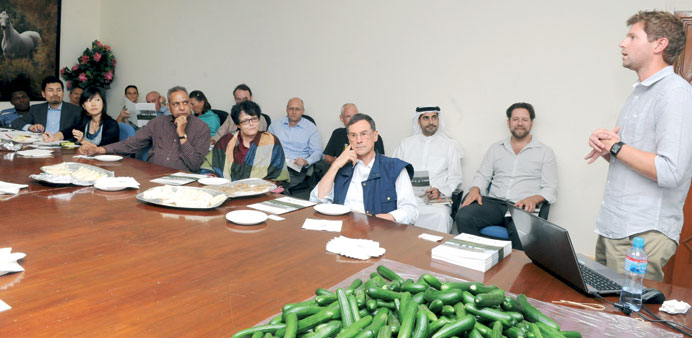By Joseph Varghese/Staff Reporter
The Sahara Forest Project (SFP) in Qatar harvested its first barley crop recently, said Patrick Brading, cultivation co-ordinator of the project.
Speaking at a meeting of SustainableQatar held at the Friends of Environment Centre (FEC), Patrick said that large scale cultivation through Sahara Forest Project (SFP) can result in thousands of employment opportunities, production of many crops, bio-fuel production and many more.
He further said that barley was grown on the sandy soil at the pilot facility, located in the Qatari desert. Barely is so far the only crop other than cucumber that is cultivated by the SFP in Qatar besides desert flowers. The Qatari project which is in the pilot phase was opened by the His Highness the Heir Apparent last December.
Patrick highlighted that large scale cultivation in 4,000 hectares of land could result in direct employment for 6,000 people and indirectly 30,000. “This is an investment opportunity of $1.5 to 2bn with an annual production of 173,000 tonnes of tomatoes, 7.5mn litres of bio fuel, and permanent CO2 storage of 495,000 tonnes per year. It will also have scope for 280 Gwh clean energy for export yearly.”
He said the project in Qatar is the fastest so far. “We have two in the region, one in Qatar and the other in Jordan. The Jordan project started in 2010 while the Qatar plant started in 2012 and by the end of 2012 the pilot project opened in Qatar. We have had already three crops of cucumber and one barley cultivation. The Jordan project is also in the pilot phase.”
SFP official claims that it offers a number of technologies to overcome many of the challenges related to food security in Qatar and the wider region. In 2011 SFP entered into co-operation with Yara ASA, the world’s largest supplier of fertiliser and Qafco. After a feasibility study on Qatar, the parties signed an agreement to build the first fully operational Sahara Forest Project Pilot Plant in Qatar.
The SFP pilot facility in Qatar provides a unique research platform to demonstrate and optimise environmental technologies that will enable restorative growth in desert areas around the world.

Patrick Brading speaking at the function.
